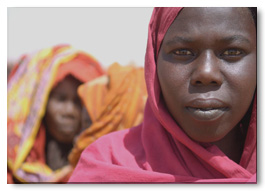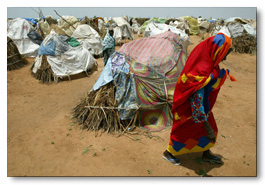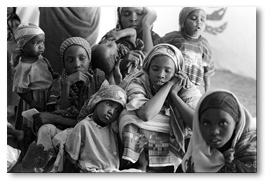The Future of Darfur
- ERIC REEVES
For Suad Abdalaziz, prospects are bleak.
 |
A Zaghawa tribeswoman from the Tawilla area of Northern Darfur, Suad was raped repeatedly by three Janjaweed militiamen in February, 2004. The Janjaweed were ferociously active that month in the Tawilla region; in a single assault, led by the notorious Musa Hilal, they burned to the ground more than 30 villages, killing more than 200 people and raping more than 200 girls and women some by up to 14 assailants and in front of their fathers, who were later killed. The men who raped Suad told her, We want to change the colour of your children. And they did: Nine months later, she bore a daughter. Now she is unlikely to get married, because, as she put it, I have lost my honour.
Suad was living in the Abu Shouk camp for displaced persons in Darfur when she told her story to a reporter from Knight Ridder in November, 2004. Eighteen months later, the Darfur genocide shows no signs of abating, and Abu Shouk remains a makeshift home for many of the survivors of the Tawilla attacks. Throughout Darfur and in Chad, many have died in these camps over the last three years, so it is possible that Suad is no longer alive. But if she is, we might ask: What will her future and the future of the more than two-million internally displaced persons and international refugees who have been chased from their towns by Arab militias and remain trapped in squalid camps look like? What will become of their homeland, Darfur, where about six million people lived before the massacres began in 2003? It is impossible to answer these questions definitively. But it is not too soon to ask.
To understand where Darfur might be headed, you first have to understand what the area was like before the Sudanese government unleashed Janjaweed militias on the regions African tribal populations in early 2003. Darfur has long been the home of Arab nomads who, in recent decades, have been favoured by Sudans Arab supremacist National Islamic Front (NIF) regime and African tribal groups (the Fur, Masalit, Zaghawa, and others). Most members of these African groups were sedentary agriculturalists: They grew millet, sorghum and groundnuts; the accumulation of livestock was the main means of preserving wealth. Darfuris were devout Muslims, but family and tribe were the essential social elements, and there was little need for Khartoums vehement version of Sharia. Educational opportunities were limited, as were medical resources. And yet, in a harsh, arid climate, Darfurs residents carved out for themselves a remarkably rich and resilient life.
The social fabric of Darfur the generations of understanding and relatively stable co-existence between African farmers and Arab nomads began to fray decades ago; but, in 2003, things took a sharp turn for the worse when Khartoum arrived at a ruthless strategy for fighting two Darfuri rebel groups. In order to defeat the insurgents and to ensure that they would not serve as an example to Sudans other marginalized populations, Khartoum and its Janjaweed proxies relentlessly attacked the villages of the African tribal groups to which the insurgents belonged.
 |
The attacks were comprehensive and revealed a rich understanding of what was most likely to destroy the future ability of African groups to live in Darfur. Irrigation systems were destroyed; water wells were poisoned with human and animal corpses; pottery vessels were broken to make carrying water impossible; foodstocks were annihilated; cattle were killed or looted; fruit trees were cut down or burned; agricultural tools were smashed; mosques and Korans were desecrated; buildings were torched. And, of course, people were displaced, raped and killed.
Many of the survivors now live in camps for refugees and internally displaced persons, both in eastern Chad and Darfur. Separated from their livelihoods, they are wholly dependent for survival on humanitarian organizations (which are forever on the brink of having to leave for lack of money, lack of security, or both). They arrived in the camps with nothing, and they have nothing to go back to.
What does the future hold for these people? In the short term, the coming rainy season from June through September could be the period of greatest human destruction to date. This is the traditional hunger gap, the months between spring planting and fall harvest. It is also the time when water-borne diseases pose the greatest threat in crowded camps filled with weakened people. (And it wont help that the United Nations halved refugees food supplies last week.)
It is in the long term, however, that the genocides perpetrators will have their true victory: They have not only killed individuals, but also destroyed an entire way of life. Attackers have targeted men and boys; this will make it particularly difficult for traditionally maleled farming communities to reconstitute themselves. Moreover, children who come of age during the genocide will not have learned the agricultural skills necessary for survival in this unforgiving land. As a result, agricultural life in Darfur will be seriously compromised for the foreseeable future.
And, if those communities cannot reconstitute themselves, even after the killing has ended then what? Boys, seething with anger at what they have suffered, are ripe for recruitment into Darfurs insurgency movements. Others have already begun to drift toward urban areas, either in Darfur or in neighbouring Kordofan Province, or even farther east toward Khartoum. There, these children, with few useful skills and little education, will find themselves part of an enormous population of underemployed workers. Poverty has created what is, for Darfur, an entirely uncharacteristic problem: prostitution. Already, crime and warlordism are endemic, as Darfuris seek new ways to make a living.
 |
All evidence of the last half-century grimly suggests that the longer people remain in camps for refugees or displaced persons, the more likely it is they will never leave. Money for humanitarian groups is short; donor fatigue has set in. Poverty, malnutrition, disease these are likely to be the defining features of life in the camps. A decade from now, the larger camps will almost certainly still exist in some form. They will likely become ghastly suburbs; this, at any rate, is what happened to the camps around Khartoum, where hundreds of thousands of southern Sudanese displaced by decades of civil war have more or less given up on the chance of returning to their homes. It will be a long time before life in Darfur returns to normal if it ever does.
And yet, the fact that there will be no good outcomes for Darfur does not absolve the West of the obligation to seek better outcomes to try, however belatedly, to mitigate the damage already done. The tasks are twofold: to create security in the region by disarming the murderous Janjaweed and to open the political space necessary for reconciliation by keeping the troops and, just as importantly, the influence of Sudans central government at bay.
This does not mean Darfur would become an independent nation. It simply means that Western troops must create enough security on the ground for Darfuris to begin returning to their villages; for humanitarian groups to operate freely, since it will be a long time before substantial agricultural production resumes; and for Arab and African tribal leaders to reassert their traditional authority, free from the NIFs destructive meddling.
This last step is imperative for a number of reasons: First, many hundreds of millions of dollars in generational wealth have been destroyed in the genocide; and, while Khartoum must provide the lions share of the money, it should be divided up by local arbitrators. Second, while the genocides masterminds should be tried at the International Criminal Court, justice for many of the lesser criminals could conceivably play out at the local level, as it has in Rwanda. Finally, land use, a source of ethnic tension for generations, must be negotiated locally in a way that addresses the grievances of Arab tribal groups prominent in the Janjaweed.
None of this, however, can happen without security, which only Western troops can provide. The future of Darfur is bleak, but it can grow bleaker still. We could limit the damage, yet, so far, we have chosen inaction. And so it is not only Suad Abdalaziz who has lost her honour. For sitting by as Darfur burned, we have lost ours as well.
 This is J. Fraser Field, Founder of CERC. I hope you appreciated this piece. We curate these articles especially for believers like you.
This is J. Fraser Field, Founder of CERC. I hope you appreciated this piece. We curate these articles especially for believers like you.
Please show your appreciation by making a $3 donation. CERC is entirely reader supported.

Acknowledgement
Eric Reeves. The future of Darfur. The New Republic (May 10, 2006).
This article is reprinted with permission from The New Republic and the author, Eric Reeves.
 |
"When The New Republic was founded in 1914, its mission was to provide readers with an intelligent, stimulating, and rigorous examination of American politics, foreign policy, and culture.... We turn the news on its head and show how the herd-like press invariably latches on to political clichés that aren't just wrong, but absurd. The New Republic makes arguments startling, intricate, razor-sharp arguments and we back them up. We do that by sending our reporters to pound the pavement and burn up the telephone lines to get the information that explains why, when, and how. One more thing: TNR is funny laugh-out-loud funny. Anyone who is serious about journalism and politics knows that occasionally humor is the best way to fully capture the moment. Our Notebook section, which skewers Washington hypocrisy and double speech, is savagely witty." Subscribe to The New Republic here.
The Author
Eric Reeves is Professor of English Language and Literature at Smith College in Northampton, Massachusetts. He has spent the past seven years working full-time as a Sudan researcher and analyst, publishing extensively both in the US and internationally. He has testified several times before the Congress, has lectured widely in academic settings, and has served as a consultant to a number of human rights and humanitarian organizations operating in Sudan. Working independently, he has written on all aspects of Sudan's recent history. He has recently received a generous grant from the Humanity First Initiative of the Omidyar Network to support his research and travel. The flexibility of Smith College has allowed him to take a number of semesters as leave without pay. He is presently at work on a book surveying the international response to ongoing war and human destruction in Sudan ("Sudan Suffering a Long Way Off"). Visit his web site here.
Copyright © 2006 The New Republic

